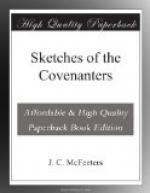5. Were they justifiable in separating from others?
6. Who joined Cameron in carrying out his commission?
7. What is the true position of Covenanters?
8. What is their mission in the world?
XXXVIII.
The lone star.—A.D. 1681.
Donald Cargill was at this time the only minister of the Society people. He was the Lone Star appearing in the firmament of the Covenanted Church. The night was very cloudy. The storm of persecution had darkened the land; the defection of the Church had deepened the darkness; the wrath of the Lord, against the persecuting nation and the Covenant-breaking Church, had covered Scotland with a woeful night. The stars had disappeared till one alone, a solitary orb, had power sufficient to pierce the deadly gloom with its lustrous rays.
Donald Cargill was the Elijah of his day, the solitary standard-bearer of the Covenant after the death of Cameron. Doubtless there were seven thousand, yea, seven thousand twice told, who had not bowed the knee to Baal; but they were hidden in caves and in holes of the rocks, waiting for some terrible display of the power and glory of the Lord. There were many stars, but the night was too dark for them to shine; also they had become almost nebulous. Even Alexander Peden, Scotland’s fiery prophet, who never weakened in the Covenant nor waned in his brilliant career—even he did not identify with the Cameronians in the declaration of war against King Charles and the demand for his abdication. Cargill was the lone leader of the dreadless Covenanters in their new and aggressive movement.
The last years of Cargill were his best, and his last services were his greatest. He grew like the cedar, increasing in strength, usefulness, and dignity till cut down by death. His zeal leaped into flames with the adverse winds: he did his noblest works when he was most sorely pressed. He conducted divine services even when wounded and bleeding; he carried the gashes of the sword into the pulpit and the scars of battle down to the grave. A glance at his wonderful career should be inspiring.
Even in childhood Cargill was noted for prayer. He grew up on a beautiful farm where the fields dip into the shady valley and ascend the lofty hills. Rugged nature taught the opening child-life to take on much beauty, grandeur, and dignity. He loitered often on the confines of the higher world in his meditations and in prayer. But especially the altar of worship, the family Bible, the fireside catechising, the stern discipline, and the solemn Sabbaths moulded the boy and awakened the powers that distinguished the man. Family religion, which was strict, solemn, and awe-inspiring made heroes of the men of the Covenant. Without family religion the children may be expected to become moral imbeciles and spiritual ciphers.




